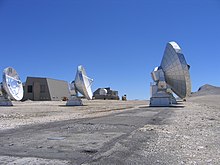Plateau de Bure Interferometer

Several of the interferometer's antennas, with one of the rails for antenna displacement in the foreground.
|
|
| Location(s) |
Grenoble |
|---|---|
| Coordinates | 44°38′02″N 5°54′29″E / 44.63389°N 5.90792°ECoordinates: 44°38′02″N 5°54′29″E / 44.63389°N 5.90792°E |
| Organization |
Institut de radioastronomie millimétrique |
| Altitude | 2,550 m (8,370 ft) |
| Built | 1988– |
| Telescope style |
radio interferometer |
| Website | www |
|
|
|
|
[]
|
|
The Plateau de Bure Interferometer is a seven-antenna interferometer on the Plateau de Bure (2550 m) in the French Alps, operated by the Institut de radioastronomie millimétrique. It is specifically designed for millimetre-wave observations and specialises in studies of line emission from molecular gas and radio continuum of cold dust.
The interferometer consists of six antennae with a diameter of 15m each. These antennae can be placed in a T-shaped pattern, with North - South track of 368m and an East - West track of 768m. There are 32 stations along these tracks where the antennae can be positioned. Observing bands are at 3,2,1.8 and 0.8 mm. At an observing wavelength of 3 mm (100 GHz frequency) each of these telescopes can resolve two objects 45 arcseconds apart from each other on the sky. In an interferometer, these 45″ are actually the size of the field of view. So an interferometer like this one images, at very high resolution (better than 1″), structures smaller than 45″.
The observatory is serviced by an aerial tramway.
On 1 July 1999 an aerial tramway car fell 80 metres (260 ft) to the valley floor. All 20 occupants were killed, in one of the worst cable car accidents in recorded history. The majority were employees and contractors of an international astronomical observatory run by the Institut de Radioastronomie Millémétrique.
...
Wikipedia

